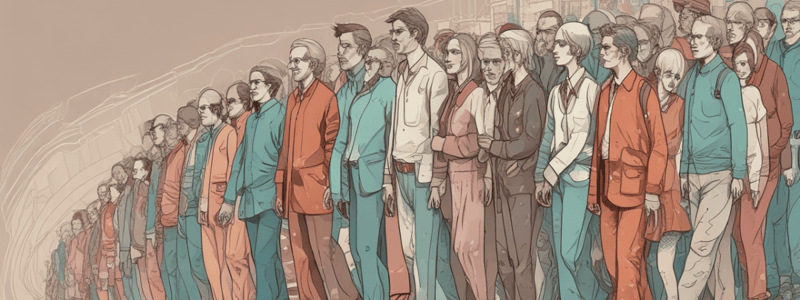Podcast
Questions and Answers
What is the term used to describe a group of people who all lived through the same certain events and time that affected their lives similarly?
What is the term used to describe a group of people who all lived through the same certain events and time that affected their lives similarly?
- Cohort (correct)
- Generation
- Demographic
- Age group
What is the name of the generation that is currently getting up into their 60s and making up a large portion of the population in the United States?
What is the name of the generation that is currently getting up into their 60s and making up a large portion of the population in the United States?
- Baby Boomers (correct)
- Millennials
- Silent Generation
- GI Generation
What is the estimated percentage of the population of North America that will be 65 years old or older by 2025?
What is the estimated percentage of the population of North America that will be 65 years old or older by 2025?
- 25 percent (correct)
- 30 percent
- 20 percent
- 13 and a 1/2 percent
Why is the age 65 significant in the study of demographics?
Why is the age 65 significant in the study of demographics?
What percentage of the elderly in the United States currently live below the poverty line?
What percentage of the elderly in the United States currently live below the poverty line?
What is the purpose of the dependency ratio?
What is the purpose of the dependency ratio?
What is a result of people living longer?
What is a result of people living longer?
What is a challenge that older people face in terms of medical insurance?
What is a challenge that older people face in terms of medical insurance?
What is the life course theory?
What is the life course theory?
What is a result of the social process of aging?
What is a result of the social process of aging?
What does the dependency ratio measure?
What does the dependency ratio measure?
Why do older people require more health services?
Why do older people require more health services?
What is the importance of readjusting society's expectations of old age?
What is the importance of readjusting society's expectations of old age?
According to age stratification theory, what role does age play?
According to age stratification theory, what role does age play?
What is the significance of older adults replacing lost social interactions?
What is the significance of older adults replacing lost social interactions?
What is the implication of the increasing dependency ratio on a population?
What is the implication of the increasing dependency ratio on a population?
Which theory suggests that older adults and society separate, allowing for self-reflection?
Which theory suggests that older adults and society separate, allowing for self-reflection?
What is a consequence of the biological processes changing as people live longer?
What is a consequence of the biological processes changing as people live longer?
What is a crucial aspect of providing long-term care and age-friendly services to older adults?
What is a crucial aspect of providing long-term care and age-friendly services to older adults?
What is a key factor contributing to the inequality in healthcare for older adults?
What is a key factor contributing to the inequality in healthcare for older adults?
Flashcards are hidden until you start studying
Study Notes
Demographic of Age
- A cohort refers to a group of people who share similar experiences and events at a certain time in their lives.
- The Baby Boomers, born post-World War II, make up a large portion of the US population and are now reaching their 60s.
- This cohort is gradually leaving the workforce, opening up jobs for younger people, but may become reliant on families or society for support.
- About 10% of the elderly in the US live below the poverty line.
Age Groups
- The Silent Generation, born during The Great Depression and World War II, is older than the Baby Boomers.
- The GI Generation, born during the first quarter of the 20th century, is the oldest living generation.
Aging Population
- Advances in medical technology have led to people living longer and in better health.
- By 2025, about 25% of North America's population will be 65 years old or older, up from 13.5% currently.
- The age 65 is significant because it's when many people retire and no longer contribute to the workforce.
Dependency Ratio
- The dependency ratio measures the number of people aged 14 and under and 65 and up, who are typically not in the labor force, compared to those aged 15-64, who are part of the productive labor force.
- A higher ratio indicates more dependent people in a population.
Impact of Aging
- Living longer enables older residents to contribute to the workforce for many more years, slowing down the inflow of the elderly into institutions.
- However, chronic illnesses and health problems affect the quality of life for millions of people, making them five times more likely to use health services than younger people.
- Age can affect access to medical insurance, creating an inequality in healthcare.
Social Responsibility
- The aging population requires a social responsibility to provide healthcare professionals specializing in old-age care and prevention of age-related diseases.
- Society needs to readjust its expectations of old age, recognizing that elderly people are essential to a community and can continue to contribute to its well-being with the right encouragement and resources.
Theories of Aging
- Life course theory views aging as a social, psychological, and biological process that begins from birth and continues until death.
- Age stratification theory suggests that age can be used to regulate the behavior of a generation.
- Activity theory looks at how older generations view themselves, and disengagement theory suggests that older adults and society separate with age.
- Continuity theory proposes that people try to maintain a same basic structure for their lives over time, adapting to external and internal changes.
Demographic of Age
- A cohort refers to a group of people who share similar experiences and events at a certain time in their lives.
- The Baby Boomers, born post-World War II, make up a large portion of the US population and are now reaching their 60s.
- This cohort is gradually leaving the workforce, opening up jobs for younger people, but may become reliant on families or society for support.
- About 10% of the elderly in the US live below the poverty line.
Age Groups
- The Silent Generation, born during The Great Depression and World War II, is older than the Baby Boomers.
- The GI Generation, born during the first quarter of the 20th century, is the oldest living generation.
Aging Population
- Advances in medical technology have led to people living longer and in better health.
- By 2025, about 25% of North America's population will be 65 years old or older, up from 13.5% currently.
- The age 65 is significant because it's when many people retire and no longer contribute to the workforce.
Dependency Ratio
- The dependency ratio measures the number of people aged 14 and under and 65 and up, who are typically not in the labor force, compared to those aged 15-64, who are part of the productive labor force.
- A higher ratio indicates more dependent people in a population.
Impact of Aging
- Living longer enables older residents to contribute to the workforce for many more years, slowing down the inflow of the elderly into institutions.
- However, chronic illnesses and health problems affect the quality of life for millions of people, making them five times more likely to use health services than younger people.
- Age can affect access to medical insurance, creating an inequality in healthcare.
Social Responsibility
- The aging population requires a social responsibility to provide healthcare professionals specializing in old-age care and prevention of age-related diseases.
- Society needs to readjust its expectations of old age, recognizing that elderly people are essential to a community and can continue to contribute to its well-being with the right encouragement and resources.
Theories of Aging
- Life course theory views aging as a social, psychological, and biological process that begins from birth and continues until death.
- Age stratification theory suggests that age can be used to regulate the behavior of a generation.
- Activity theory looks at how older generations view themselves, and disengagement theory suggests that older adults and society separate with age.
- Continuity theory proposes that people try to maintain a same basic structure for their lives over time, adapting to external and internal changes.
Demographic of Age
- A cohort refers to a group of people who share similar experiences and events at a certain time in their lives.
- The Baby Boomers, born post-World War II, make up a large portion of the US population and are now reaching their 60s.
- This cohort is gradually leaving the workforce, opening up jobs for younger people, but may become reliant on families or society for support.
- About 10% of the elderly in the US live below the poverty line.
Age Groups
- The Silent Generation, born during The Great Depression and World War II, is older than the Baby Boomers.
- The GI Generation, born during the first quarter of the 20th century, is the oldest living generation.
Aging Population
- Advances in medical technology have led to people living longer and in better health.
- By 2025, about 25% of North America's population will be 65 years old or older, up from 13.5% currently.
- The age 65 is significant because it's when many people retire and no longer contribute to the workforce.
Dependency Ratio
- The dependency ratio measures the number of people aged 14 and under and 65 and up, who are typically not in the labor force, compared to those aged 15-64, who are part of the productive labor force.
- A higher ratio indicates more dependent people in a population.
Impact of Aging
- Living longer enables older residents to contribute to the workforce for many more years, slowing down the inflow of the elderly into institutions.
- However, chronic illnesses and health problems affect the quality of life for millions of people, making them five times more likely to use health services than younger people.
- Age can affect access to medical insurance, creating an inequality in healthcare.
Social Responsibility
- The aging population requires a social responsibility to provide healthcare professionals specializing in old-age care and prevention of age-related diseases.
- Society needs to readjust its expectations of old age, recognizing that elderly people are essential to a community and can continue to contribute to its well-being with the right encouragement and resources.
Theories of Aging
- Life course theory views aging as a social, psychological, and biological process that begins from birth and continues until death.
- Age stratification theory suggests that age can be used to regulate the behavior of a generation.
- Activity theory looks at how older generations view themselves, and disengagement theory suggests that older adults and society separate with age.
- Continuity theory proposes that people try to maintain a same basic structure for their lives over time, adapting to external and internal changes.
Studying That Suits You
Use AI to generate personalized quizzes and flashcards to suit your learning preferences.




